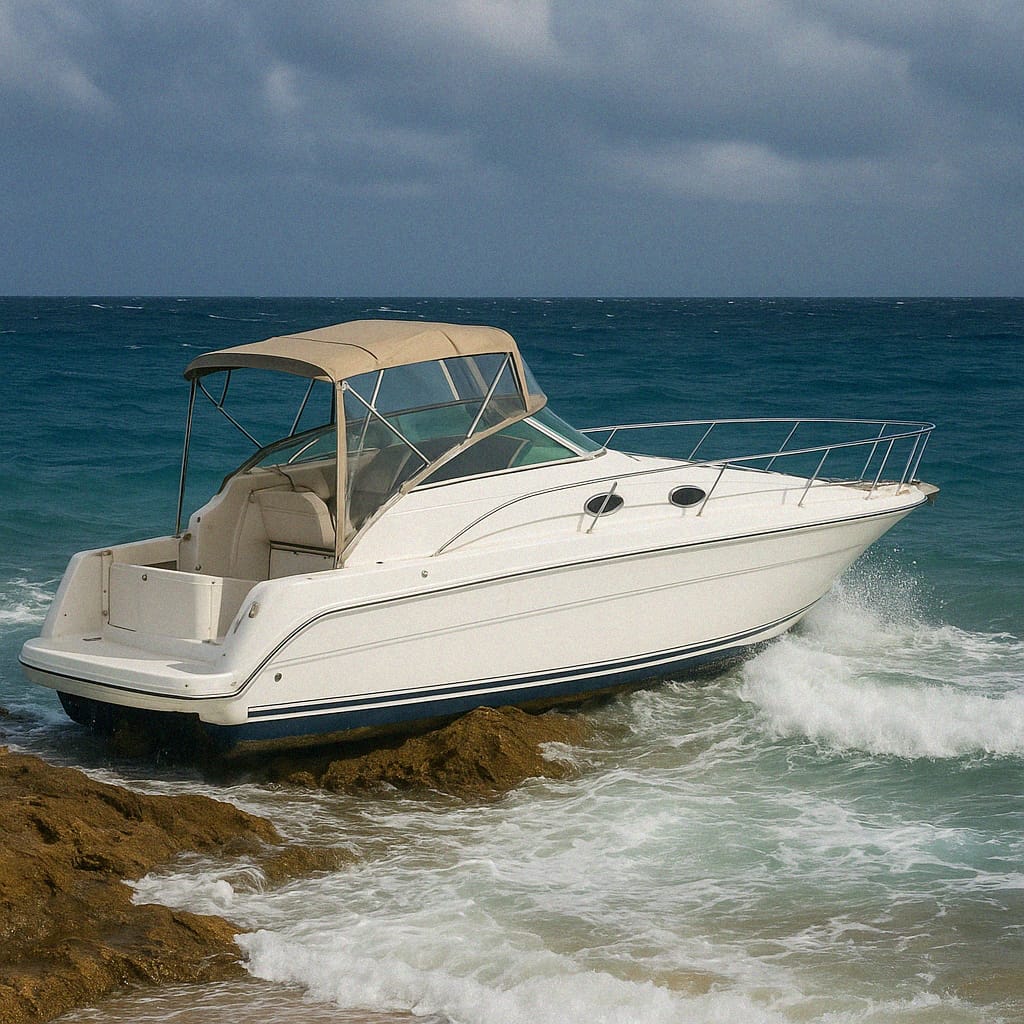1. Groundings
Aegean Sea, 2023
A 12-meter Beneteau Oceanis sailing yacht with 8 tourists on board was en route to Naxos. The skipper, relying on an outdated paper chart, failed to notice a shallow area. Wind and current quickly pushed the yacht onto a rocky shoal. A tow was required, and repairs to the hull and propeller cost the owner €25,000.
Lesson: Always use updated electronic charts and verify depths when approaching shore.
Croatia, 2022
A Lagoon 42 catamaran ran aground near Vis in the evening. The skipper relied solely on the Navionics app without checking the local Notices to Mariners. It turned out that a navigation buoy had recently been relocated, which caused the error. Two towboats and nearly 24 hours were required to free the catamaran.
Lesson: Check not only your charts but also the official Notices to Mariners.
2. Collisions
Marbella, Spain, 2024
A 9-meter motorboat collided at high speed with an inflatable dinghy in a designated swimming zone. The accident was caused by excessive speed and the skipper’s inattention—he failed to see the white inflatable hull against the sun’s glare. Three people were injured, one suffered a broken arm. The skipper was fined €15,000 and lost his license.
Lesson: Always reduce speed near shore and use polarized sunglasses for better visibility.
Rhodes, Greece, 2023
Two sailing yachts collided while entering a marina because both skippers attempted to pass through a narrow channel simultaneously, ignoring right-of-way rules. Both vessels sustained side damage totaling more than €10,000.
Lesson: The vessel on a starboard tack or the one with right-of-way must be given priority—always comply with COLREGs.

3. Capsizes and Heavy Heeling
Rhodes, 2022
During a daytime passage, a sudden squall with winds of up to 40 knots hit a sailing yacht. The mainsail was not reefed in time, causing the yacht to heel over 60°. Two crew members nearly fell overboard but were saved by their safety harnesses. The jib sheet snapped, and the cabin was partially flooded.
Lesson: Always reef your sails early and use safety harnesses in rough conditions.
Caribbean, 2021
A charter yacht with an inexperienced crew capsized after a sudden squall. The skipper had no storm-handling experience and left the sails fully hoisted. The crew was rescued by the coast guard, while the yacht was declared a total loss by the insurance company.
Lesson: Reduce sail area at the first sign of rising wind and practice emergency maneuvers.
4. Fires and Explosions
Mallorca, 2024
A fuel leak caused by a worn-out fuel hose led to a fire on a motorboat. When the skipper started the engine, gasoline vapors ignited. The crew jumped overboard and was rescued by a nearby boat. The vessel was completely destroyed.
Lesson: Check all fuel lines before departure and always ventilate the engine compartment.
Florida, 2022
An explosion occurred on a motor yacht after refueling. The engine compartment ventilation was not activated, and gasoline vapors ignited when the engine was started. Two crew members suffered burns.
Lesson: Always ventilate the engine compartment for at least 5 minutes after refueling.
5. Man Overboard and Injuries
France, 2023
During a night passage in rough seas, a crew member fell overboard. He was not wearing a safety tether. Fortunately, his AIS-MOB beacon activated automatically, and he was rescued.
Lesson: At night and in rough weather, always wear safety harnesses and personal AIS beacons.
Croatia, 2022
While docking, a crew member tried to stop the yacht by holding the mooring line with his hands. The vessel’s momentum caused a severe arm fracture.
Lesson: Never attempt to hold a boat manually—use winches and control speed properly.
How to Avoid Such Accidents
- Perform regular maintenance on your boat.
- Monitor weather forecasts and use apps like Navionics, Windy, and Boating.
- Train your crew in essential safety skills.
- Follow COLREGs and right-of-way rules.
- Use safety harnesses and life jackets.
- Never operate a vessel under the influence of alcohol.


No comments, be the first one!